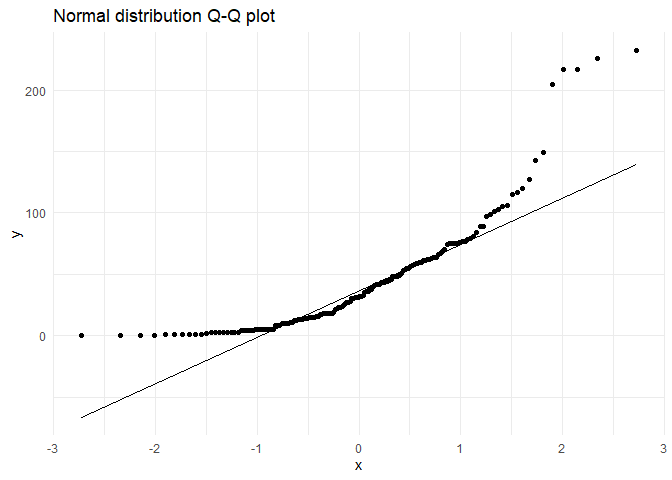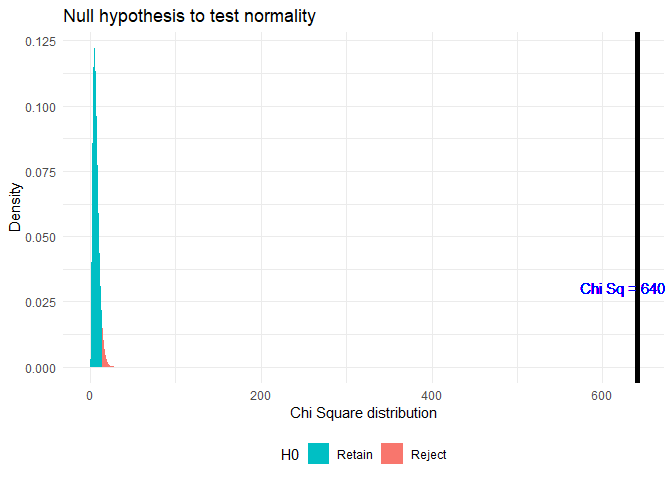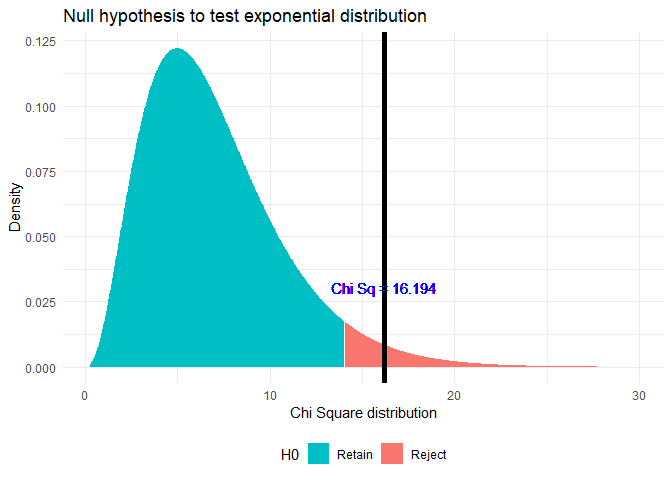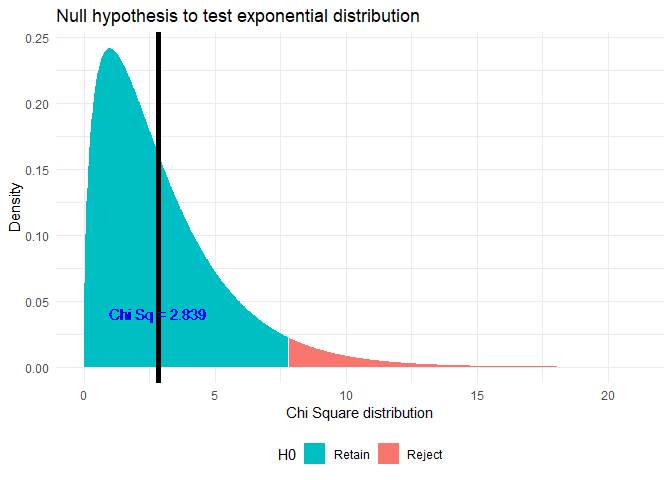Chi-Square Goodness of fit (R)
In this post, I would like to look into Chi-square goodness of fit test.
During Uni-variate analysis in EDA from the attendance data set, I tried to explain using q-q plot that the feature 'out-time-diff' is not normally distributed. To statistically prove the same, we need to use chi square tests.
ggplot(data,aes(x = alt.distr)) +
stat_function(fun = dnorm, color="darkred", size = 1,
args = list(mean = mean(data$alt.distr),
sd = sd(data$alt.distr) )) +
geom_density(aes(y=..density..), color="darkblue", size = 1)+
geom_histogram(aes(y=..density..), bins = 50, fill = "cornflowerblue", alpha = 0.2) +
labs(x = 'Out-time difference (minutes)', y='Density') +
theme_minimal()

The q-q plot for reference:
ggplot(data,aes(sample = alt.distr)) +
stat_qq() + stat_qq_line() +
ggtitle("Normal distribution Q-Q plot") +
theme_minimal()

The chi-square goodness of fit test for each group would have the following hypothesis:
\(H_0\): There is no statistically significant difference between the observed frequencies of 'diff-in-time' and expected frequencies from a normal distribution
\(H_1\): There is a statistically significant difference
The number of intervals is given by the formula,
N <- floor(1+3.3*log10(length(data$alt.distr)))
The observed and expected frequencies considering the normal distribution are as follows:
minimum.dist <- min(data$alt.distr)
maximum.dist <- max(data$alt.distr)
n <- length(data$alt.distr)
dist.mean <- mean(data$alt.distr)
dist.sd <- sd(data$alt.distr)
range.group <- (maximum.dist - minimum.dist)/N
data <- data %>% mutate(class = floor(alt.distr/range.group),
class_name_min = minimum.dist + class*range.group,
class_name_max = minimum.dist + (class+ 1)*range.group,
class_name = paste0(class_name_min, '-', class_name_max))
chi.sq.table <- data %>% group_by(class, class_name) %>% summarise(obs_freq = n(),
class_name_min = mean(class_name_min),
class_name_max = mean(class_name_max)) %>%
mutate(exp_freq = pnorm(class_name_max, dist.mean, dist.sd)*n - pnorm(class_name_min, dist.mean, dist.sd)*n,
chi.sq = ((obs_freq - exp_freq)^2)/exp_freq)
library(kableExtra)
kable(chi.sq.table %>% dplyr::select(class_name, obs_freq, exp_freq, chi.sq),
caption = 'Cross Tabulation') %>%
kable_styling(full_width = F) %>%
column_spec(1, bold = T) %>%
collapse_rows(columns = 1:2, valign = "middle") %>%
scroll_box()
| class | class_name | obs_freq | exp_freq | chi.sq |
|---|---|---|---|---|
| 0 | 0-29 | 74 | 32.0974138 | 54.7030591 |
| 1 | 29-58 | 37 | 39.1354970 | 0.1165271 |
| 2 | 58-87 | 28 | 32.4557899 | 0.6117264 |
| 3 | 87-116 | 9 | 18.3059346 | 4.7307292 |
| 4 | 116-145 | 4 | 7.0201144 | 1.2992795 |
| 5 | 145-174 | 1 | 1.8295669 | 0.3761443 |
| 7 | 203-232 | 4 | 0.0389060 | 403.2865367 |
| 8 | 232-261 | 1 | 0.0031698 | 313.4780888 |
Performing the Chi-square test of independence:
# Functions used in chi-sq-test
chi.sq.plot <- function(pop.mean=0, alpha = 0.05, chi.sq, df,
label = 'Chi Square distribution',title = 'Chi Square goodness of fit test'){
# Creating a sample chi-sq distribution
range <- seq(qchisq(0.0001, df), qchisq(0.9999, df), by = (qchisq(0.9999, df)-qchisq(0.0001, df))*0.001)
chi.sq.dist <- data.frame(range = range, dist = dchisq(x = range, ncp = pop.mean, df = df)) %>%
dplyr::mutate(H0 = if_else(range <= qchisq(p = 1-alpha, ncp = pop.mean, df = df,lower.tail = TRUE),'Retain', 'Reject'))
# Plotting sampling distribution and x_bar value with cutoff
plot.test <- ggplot(data = chi.sq.dist, aes(x = range,y = dist)) +
geom_area(aes(fill = H0)) +
scale_color_manual(drop = TRUE, values = c('Retain' = "#00BFC4", 'Reject' = "#F8766D"), aesthetics = 'fill') +
geom_vline(xintercept = chi.sq, size = 2) +
geom_text(aes(x = chi.sq, label = paste0('Chi Sq = ', round(chi.sq,3)), y = mean(dist)), colour="blue", vjust = 1.2) +
labs(x = label, y='Density', title = title) +
theme_minimal()+theme(legend.position="bottom")
plot(plot.test)
}
chi.test <- chisq.test(chi.sq.table$obs_freq, p = chi.sq.table$exp_freq, rescale.p = TRUE)
print(chi.test)
##
## Chi-squared test for given probabilities
##
## data: chi.sq.table$obs_freq
## X-squared = 640.34, df = 7, p-value < 2.2e-16
chi.sq.plot(chi.sq = chi.test$statistic, df = chi.test$parameter, title = 'Null hypothesis to test normality')

As p < α, where α = 0.05, rejecting the Null hypothesis.
In the same post, I showed using Q-Q plot how the distribution looks like an exponential distribution. To test if it is statistically significant, I will use the Chi-Square test.
The chi-square goodness of fit test for each group would have the following hypothesis:
\(H_0\): There is no statistically significant difference between the observed frequencies of 'diff-in-time' and expected frequencies from exponential distribution
\(H_1\): There is a statistically significant difference
minimum.dist <- min(data$alt.distr)
maximum.dist <- max(data$alt.distr)
n <- length(data$alt.distr)
lamda <- 1/mean(sd(data$alt.distr),mean(data$alt.distr))
range.group <- (maximum.dist - minimum.dist)/N
data <- data %>% mutate(class = floor(alt.distr/range.group),
class_name_min = minimum.dist + class*range.group,
class_name_max = minimum.dist + (class+ 1)*range.group,
class_name = paste0(class_name_min, '-', class_name_max))
chi.sq.table <- data %>% group_by(class, class_name) %>% summarise(obs_freq = n(),
class_name_min = mean(class_name_min),
class_name_max = mean(class_name_max)) %>%
mutate(exp_freq = pexp(class_name_max, lamda)*n - pexp(class_name_min, lamda)*n,
chi.sq = ((obs_freq - exp_freq)^2)/exp_freq)
| class | class_name | obs_freq | exp_freq | chi.sq |
|---|---|---|---|---|
| 0 | 0-29 | 74 | 73.9534204 | 0.0000293 |
| 1 | 29-58 | 37 | 39.3388103 | 0.1390493 |
| 2 | 58-87 | 28 | 20.9259016 | 2.3914319 |
| 3 | 87-116 | 9 | 11.1313320 | 0.4080892 |
| 4 | 116-145 | 4 | 5.9212050 | 0.6233577 |
| 5 | 145-174 | 1 | 3.1497280 | 1.4672157 |
| 7 | 203-232 | 4 | 0.8912488 | 10.8435869 |
| 8 | 232-261 | 1 | 0.4740912 | 0.5833899 |
I observe that the expected frequency value is close to the observed frequency value in most of the cases.
##
## Chi-squared test for given probabilities
##
## data: chi.sq.table$obs_freq
## X-squared = 16.194, df = 7, p-value = 0.0234

From the table above, I can see that most of the high chi-sq values are due to Class 7 and 8 where observed frequency is less than 10. Ignoring those cases, I get:
##
## Chi-squared test for given probabilities
##
## data: chi.sq.table$obs_freq
## X-squared = 2.8385, df = 3, p-value = 0.4172

As p > α, where α = 0.05, retaining the Null hypothesis
I want to find the effect size or the strength of relationship between these variables. That is explained by Cramers-V by
library(lsr)
cramersV(chi.sq.table$obs_freq, p = chi.sq.table$exp_freq, rescale.p = TRUE)
## [1] 0.03988245